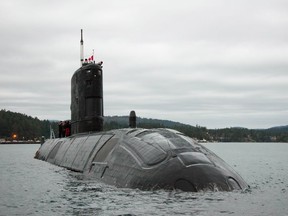
Contents of the article
OTTAWA — German Defense Minister Boris Pistorius said Tuesday that if Canada joins a submarine partnership with Norway, the three countries could pool resources and shipyard parts.
Advertisement 2
Contents of the article
“Our cooperation will range from sharing shipyards and logistics on both sides of the Atlantic to sharing our crews, and even in the Indo-Pacific region,” he said.
Contents of the article
Contents of the article
The defense ministers of Germany and Norway—partner countries in the purchase of the first Project 212CD submarines from ThyssenKrupp Marine Systems—were in Ottawa this week in glamor touting the vessels as bidding for Canada's own subcontract heats up.
Pistorius spoke of the benefits of a cooperative submarine alliance as he promoted his sales in Ottawa in support of ThyssenKrupp Marine, the German firm bidding for a lucrative Canadian submarine contract.
He said while competitors could make a cheaper offer, Germany's offer provides “a strong partnership for decades to come when it comes to cooperation in the North Atlantic.”
Contents of the article
Advertisement 3
Contents of the article
His visit comes just days before Prime Minister Mark Carney's planned trip to Asia, where he is expected to visit a South Korean shipyard run by rival bidder Hanwha.
Carney visited ThyssenKrupp Marine's submarine paddock in Kiel, Germany, on 26 August.
The defense ministers of Germany and Norway met with a parade of cabinet ministers this week.
On Monday they met with Industry Minister Melanie Jolie and Defense Minister David McGuinty. They spoke to Natural Resources Minister Tim Hodgson on Tuesday.
They also met with Stephen Fuhr, the secretary of state in charge of defense acquisitions.
Pistorius said Germany was “very interested in cooperating” with Canada “on raw materials, hydropower, LNG,” as well as purchasing aircraft and software from Canadian firms.
Advertisement 4
Contents of the article
“There are several areas of cooperation that we are currently exploring with our Canadian friends,” he said.
He also said that if Canada wanted it, ThyssenKrupp Marine could manufacture some or parts for the 212CD submarines domestically.
“If Canada decides … to want to produce products on its own, on its own territory, from what point on, then that is also possible,” he said.
Canada has only four submarines and they are due to be retired by 2035, making a major procurement project a priority for the government as it races to find replacements.
ThyssenKrupp Marine said it could beat Canada's tight 2035 delivery deadline for the first submarine.
Meanwhile, Hanwha attempted to leverage its enormous shipyard capacity by proposing an aggressive delivery schedule.
Advertisement 5
Contents of the article
Hanwha says it could build four KSS-III submarines by 2035, with the first delivered in 2032, and then send a new submarine to Canada every year after the first four are delivered, resulting in a full fleet of 12 submarines by 2043.
ThyssenKrupp Marine and its partner governments highlighted the benefits of interoperability among operational submarines also used by NATO allies.
Norwegian Defense Minister Tore Sandvik said his country and Germany collectively support their respective submarine fleets.
“We can stockpile together in times of crisis and war,” he said.
He also said Norway was preparing a submarine maintenance facility at Haakonsvern Naval Base and offered to share those designs so Canada could build its own facility, which would shorten delivery times and speed up maintenance.
Advertisement 6
Contents of the article
“We told Canada to reduce the lead time as well as the construction of maintenance bays, they can have a design… (so as to) not reinvent the wheel again, which makes a big difference,” Sandvik said.
Deloitte's Daniel Kerry, who has worked on the UK's submarine program, previously told The Canadian Press that the fleet of new submarines may be the most expensive and complex thing National Defense will ever buy.
“This is essentially an underwater space rocket—so incredibly complex—and it comes with a significant amount of risk, not only in purchase, design and assembly, but also in operation,” he said.
“Canada will own these fleets for 40 to 50 years after they go through procurement, so you're unlikely to make that decision.”
Read more
Contents of the article









